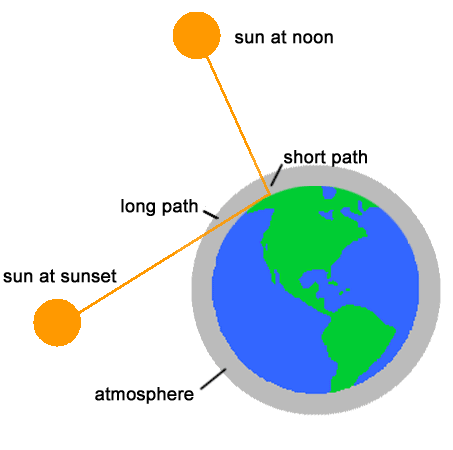



Whenever it's not completely filled with clouds, we can see that the sky is blue. As the sun rises and as it sets, it looks red. These two observations are related, as this experiment will show.
You will need the following materials:
Set the container on a table where you can view it from all sides. Fill it ¾ full with water. Light the flashlight and hold it against the side of the container so its beam shines through the water. Try to see the beam as it shines through the water. You may be able to see some particles of dust floating in the water; they appear white. However, it is rather difficult to see exactly where the beam passes through the water.
Add about 60 milliliters (¼ cup) of milk to the water and stir it. Hold the flashlight to the side of the container, as before. Notice that the beam of light is now easily visible as it passes through the water. Look at the beam both from the side and from the end, where the beam shines out of the container. From the side, the beam appears slightly blue, and on the end, it appears somewhat yellow.
Add another ¼ cup of milk to the water and stir it. Now the beam of light looks even more blue from the side and more yellow, perhaps even orange, from the end.
Add the rest of the milk to the water and stir the mixture. Now the beam looks even more blue, and from the end, it looks quite orange. Furthermore, the beam seems to spread more now than it did before; it is not quite as narrow.
What causes the beam of light from the flashlight to look blue from the side and orange when viewed head on? Light usually travels in straight lines, unless it encounters the edges of some material. When the beam of a flashlight travels through air, we cannot see the beam from the side because the air is uniform, and the light from the flashlight travels in a straight line. The same is true when the beam travels through water, as in this experiment. The water is uniform, and the beam travels in a straight line. However, if there should be some dust in the air or water, then we can catch a glimpse of the beam where the light is scattered by the edges of the dust particles.
When you added milk to the water, you added many tiny particles to the water. Milk contains many tiny particles of protein and fat suspended in water. These particles scatter the light and make the beam of the flashlight visible from the side. Different colors of light are scattered by different amounts. Blue light is scattered much more than orange or red light. Because we see the scattered light from the side of the beam, and blue light is scattered more, the beam appears blue from the side. Because the orange and red light is scattered less, more orange and red light travels in a straight line from the flashlight. When you look directly into the beam of the flashlight, it looks orange or red.
What does this experiment have to do with blue sky and orange sunsets? The light you see when you look at the sky is sunlight that is scattered by particles of dust in the atmosphere. If there were no scattering, and all of the light travelled straight from the sun to the earth, the sky would look dark as it does at night. The sunlight is scattered by the dust particles in the same way as the light from the flashlight is scattered by particles in milk in this experiment. Looking at the sky is like looking at the flashlight beam from the side: you're looking at scattered light that is blue. When you look at the setting sun, it's like looking directly into the beam from the flashlight: you're seeing the light that isn't scattered, namely orange and red.
What causes the sun to appear deep orange or even red at sunset or sunrise? At sunset or sunrise, the sunlight we observe has traveled a longer path through the atmosphere than the sunlight we see at noon. Therefore, there is more scattering, and nearly all of the light direct from the sun is red.

| For additional information, see CHEMICAL DEMONSTRATIONS: A Handbook for Teachers of Chemistry, Volume 3, by Bassam Z. Shakhashiri, The University of Wisconsin Press, 2537 Daniels Street, Madison, Wisconsin 53704. |